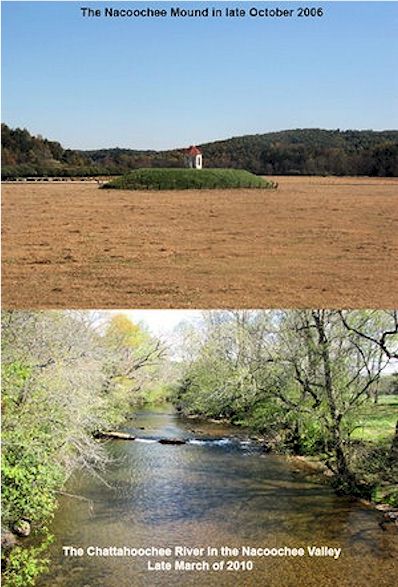In 1824 gold was officially “re-discovered” in the Dukes Creek area of the Nacoochee Valley. After word was slowly spread around the nation about the large gold deposits by couriers and newspapers, thousands of men from throughout the United States rushed to the Georgia Mountains to seek their fortune. They ignored the fact that the Nacoochee Valley was within the sovereign territory of the Cherokee Nation. The Cherokee population of the valley probably number no more than a hundred. There was nothing they could do. They were a beaten people.
The State of Georgia cleverly solved the problem by sending formal notification to the Cherokee Nation’s leaders that they had misunderstood the boundary line and English of the 1793 Treaty. Georgia officials kindly provided the Cherokees with new maps which showed the Nacoochee, Dahlonega and Auraria gold fields to be east of the Cherokee Nation. The Cherokees didn’t understand the whites’ obsession with gold or with mountain lands containing very little bottom land. Very few of their citizens lived in the gold fields, so they protested very little. Thus, as of 1824, the Nacoochee Valley was no longer in the Cherokee Nation.
The best gold mining locations in the Nacoochee Valley were quickly gobbled up by corporations and partnerships founded by wealthy coastal planters. Senator John C. Calhoun was one of the biggest mine operators. The mining conglomerates often hired Cherokees as workers. These workers lived outside the boundaries of the Cherokee Nation, and thus were considered citizens of Georgia. Many of the people in the Nacoochee Valley, who claim some Cherokee ancestry are descended from these miners.
Some of the richest deposits were very close to the Great Appalachian Valley where most of the Cherokees were concentrated. Some violence did occur, though, as miners discovered gold veins farther west. Whenever there were problems, Georgia did its best to blame the Cherokees and punish them. Many miners solved the problem of mining land they didn’t own, but marrying Cherokee women. That automatically gave them the right to be inside the Cherokee Nation. Descendants of these men who married to get Cherokee land, are probably the largest group of Cherokee descendants in Georgia today.
One of the most common myths about the Cherokees that one reads in books today is that the Trail of Tears occurred because gold was discovered on Cherokee land. Georgia grabbed the most productive gold lands almost immediately after the rush began. It is true that some of the Cherokee Nation was divided up into “gold lots” and commercial gold mining operations continued until the early 20th century. However, the main incentive of sending the Cherokees out of the state was for coastal planters to grab large tracts of fertile river bottomlands in northwest Georgia to build plantations.
In 1848 word of the discovery of gold in northern California reached the Georgia Mountains. A wagon train of Georgia gold miners was preparing for the long trek across the continent when the editor of the Dahlonega Nugget newspaper went out on the courthouse square to give a speech, which would persuade them to stay in Georgia. He ended it with the statement that went something like, “Stay here fellows! There is still gold in those hills!”
Georgia gold miners taught the newcomers to California how to mine gold. Many returned home wealthy enough to build a plantation. Some returned home with nothing, or died trying. Georgia gold miners were again the core of the Colorado gold rush. Auraria, Colorado was named after Auraria, Georgia.
The Summer Home Era
From 1824 until the 1870s the Nacoochee Valley essentially remained part of the frontier. Most of its residents were yeoman farmers living in log houses. They were more prosperous than most mountain farmers because the soil was fertile and the climate temperate. However, access to the valley was difficult from the south and east, but almost impossible from the north and west. Nearby Clarksville had been a resort since the 1780s. That brought some cultural exposure to the locals, that was not possible in many other parts of the Southern Highlands.
Beginning immediately after the Civil War, northern capitalists (known to Georgians at the time as carpetbaggers) bought up hundreds of thousands of mountain land at pennies per acre. As the South’s economy began to recover, northern capitalists created railroad companies to build ‘modern’ transportation access to the virgin forests they intended to harvest. Soon, however, many of these businessmen began to see the recreational potential of these mountains. They promoted tourist attractions such as Tallulah Gorge and the Nacoochee Valley. Once the valley could be reached by train affluent Georgians built summer homes there along a road than ran from the train station to Clarksville.
The Nacoochee Valley remained the quiet abode of big Victorian summer homes and quaint 1920ish cabins until the 1970s. Four things completely changed the situation. Atlanta’s population and affluence exploded. The interstate highway system in northern Georgia was completed. The movie, “Deliverance” was filmed near the Nacoochee Valley. Finally, the dreams in the 1960s of converting a saw mill town into an alpine village, became a reality. All the world was driving to visit Helen, but happened to notice the Indian mound with a white gazebo on top.
Today, the old train station near the Nacoochee Mound is empty again. It was moved a bit to get it away from the highway and then went through a series of not-so-successful occupants. Few corporate transplants from Atlanta even realize that it was once a place where generations of Georgians got off the steam locomotive pulled passenger cars to the shouts of, “Mama, Daddy, Let’s go picnic on the Nacoochee Mound!”

